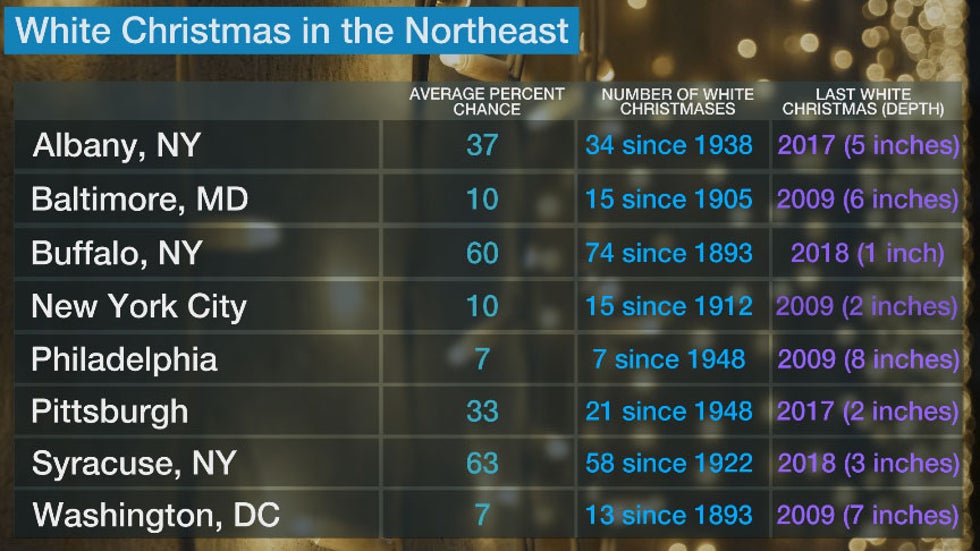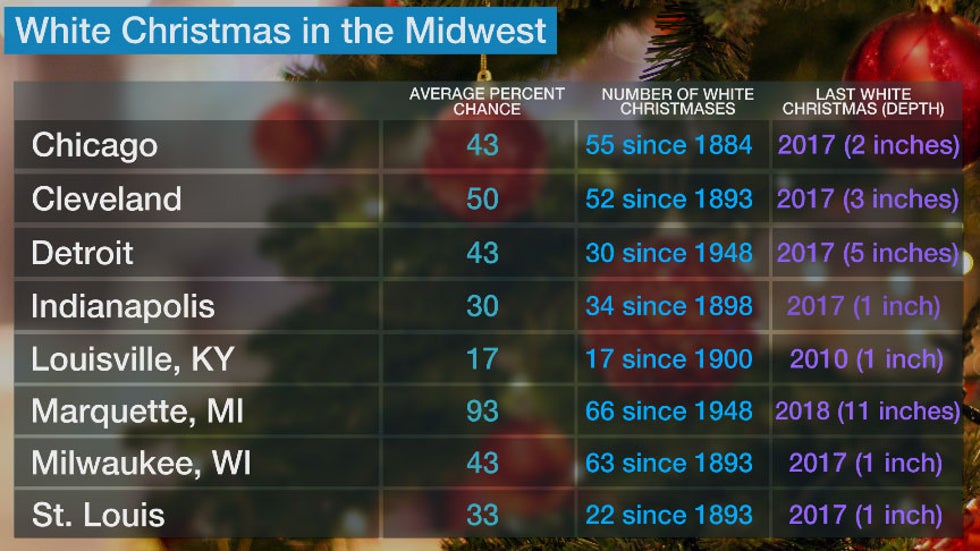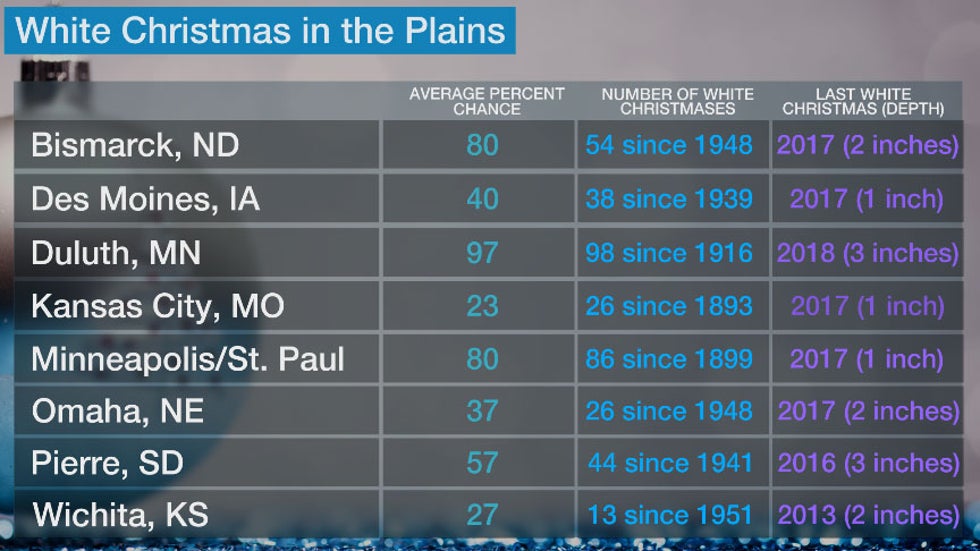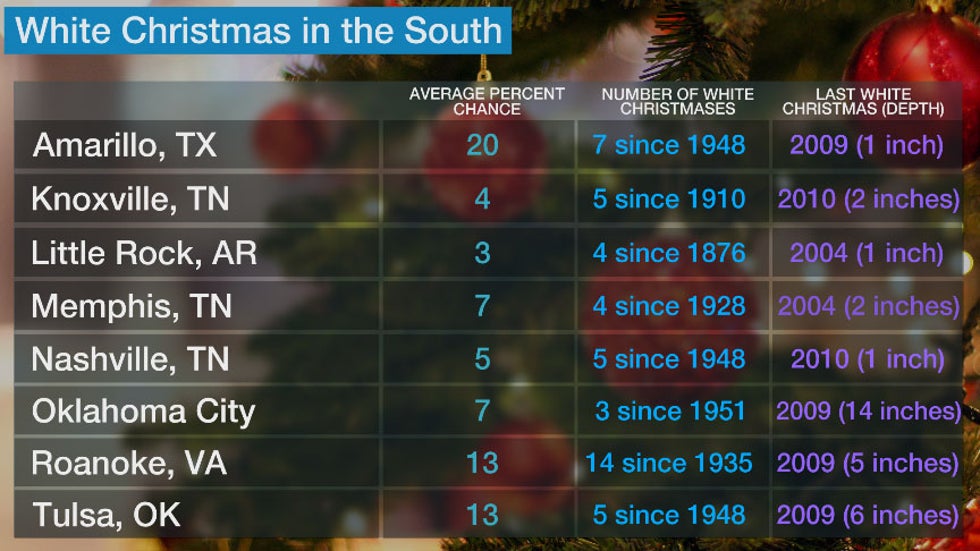
Many dream of experiencing a white Christmas, but where is your best shot of seeing one in any given year?
While it is too early to determine where there will be snow on the ground on Christmas this year, history provides a look at where there is a greater chance for a white Christmas. (Check back with us at weather.com in the days ahead for our forecast for this year.)
Spoiler: You're in luck in parts of the northern states and higher elevations of the West.
How Typical Is a White Christmas?
In meteorology, a white Christmas occurs when there is at least 1 inch of snow on the ground Christmas morning. It doesn't have to be snowing on the holiday for that to happen.
The map above shows the locations with a historical chance for a white Christmas in any given year. The chances are based on climatological averages from 1981-2010.
You may be surprised to see there isn't a lot of territory outside the Mountain West, northern New England and the far northern tier where the odds of a white Christmas are greater than 50%.
Last Christmas brought that point home. Christmas 2018 had the least expansive snow cover in the Lower 48 states since 2005, with just 24.6% of the Lower 48 experiencing a white Christmas, according to an analysis from the NOHRSC.
The lack of snow was partly due to relatively mild conditions across the U.S. in December 2018. Most of the Midwest and East saw above-average temperatures.
This was also much less than 2017, when just under half of the U.S. had snow on the ground Christmas morning. That year, snow cover was observed across the northern tier as expected, but also reached into portions of the Central Plains, Midwest and Northeast.
On average, about 40% of the Lower 48 states have snow on the ground on Christmas, according to 16 years of data compiled by the NOHRSC. Since 2003, those percentages have varied widely from year-to-year, from 21% in 2003 to a whopping 63% of the contiguous U.S. in 2009.
Regional Historical Odds
Below we break down various white Christmas statistics, including the yearly probability, the number of white Christmases in each city's historical record and the last white Christmas. All statistics and data are courtesy of the National Weather Service.
The annual probability is based on the 30-year average from 1981-2010.
Northeast
The most snow on the ground in Albany, New York (in 1966), and Buffalo, New York (in 2001), on Christmas morning was 19 inches. Philadelphia has seen up to a foot of snow on the ground on Christmas (in 1966), while 7 inches is the top snow depth in Washington D.C. (in 2009).
Last Christmas, just an inch of snow was on the ground in Buffalo, while Syracuse measured 3 inches.

Burlington, Vermont, and Caribou, Maine, have seen more than 30 inches of snow on the ground in Christmases past. In 2018, both cities saw a white Christmas again, with 2 inches on the ground in Burlington and a half foot in Caribou.
The record Christmas snow depth in Boston is 11 inches in 1995 and 18 inches is the highest Christmas depth on record in Providence, Rhode Island.

Midwest
The top snow depth on record for Christmas morning in Milwaukee is 25 inches (in 2000) and the record in Chicago is 17 inches (in 1951).
Last year, little snow was on the ground outside of the northern and central Great Lakes. One of the higher totals in the region was in Marquette, Michigan, which reported 11 inches on Christmas morning in 2018.

Plains
Duluth, Minnesota, and Pierre, South Dakota, have seen more than 2 feet of snow on the ground on Christmas. The record in Wichita, Kansas, is 4 inches (in 2007).
In 2018, only a trace of snow was observed on Christmas morning in Minneapolis and Bismarck, North Dakota, meaning it was not an official white Christmas. Duluth reported 3 inches on the ground last year.

West
The highest snow depth on Christmas morning in Tahoe City, California, is 52 inches (in 1970. Denver's record is two feet (in 1982). No snow was on the ground last Christmas in Denver, and Tahoe City saw only one inch.
Two years ago, Seattle and Portland, Oregon, both experienced their sixth white Christmas on record. Seattle measured 2 inches of snow on Christmas morning. Only 2008 and 1965 had more snow on the ground in Seattle than Christmas 2017.

Yes, It Has Happened in the South
Christmas snow cover isn't just a northern thing. Some years, parts of the southern U.S. have marveled at the sight of a white Christmas.
The greatest Christmas snow depth in both Memphis (10 inches) and Nashville, Tennessee (6 inches), took place in 1963.
It has been at least nine years since a white Christmas was observed in most of the South, although Tulsa, Oklahoma observed a trace of snow in 2017.

Three relatively recent events brought an unusual Christmas Day snow cover to parts of the South:
-2009 saw Oklahoma City's snowstorm of record (13.5 inches) and one of only two white Christmases on record in Dallas (2 inches).
-2004 brought a record snowstorm to Corpus Christi, Texas (4.4 inches), and the first day of measurable snow since 1895 to Brownsville, Texas (1.5 inches). Brownsville is on the same latitude as Miami.
-In 1989, a pre-Christmas snow was followed by a strong arctic cold outbreak that brought both Charleston, South Carolina (4 inches), and Savannah, Georgia (2 inches), their only white Christmases. Jacksonville, Florida, missed a white Christmas by one day when an inch of snow was left on the ground Christmas Eve morning.
The Weather Company’s primary journalistic mission is to report on breaking weather news, the environment and the importance of science to our lives. This story does not necessarily represent the position of our parent company, IBM.
The Weather Company’s primary journalistic mission is to report on breaking weather news, the environment and the importance of science to our lives. This story does not necessarily represent the position of our parent company, IBM.

No comments:
Post a Comment